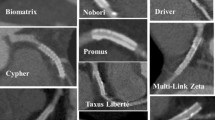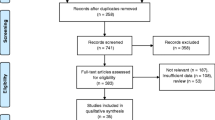Abstract
Objectives
To evaluate the incidence and diagnostic performance of reverse attenuation gradient (RAG) sign in patients with coronary stent occlusion.
Methods
We retrospectively included patients with suspected restenosis who underwent both coronary computed tomography angiography (CCTA) and invasive coronary angiography (ICA) within 2 weeks. Stent occlusion at CCTA was defined as (1) complete contrast filling defect of large calibre stents (at least 3 mm), or (2) presence of RAG sign in patients with small calibre stents (less than 3 mm) or (3) presence of RAG sign in patients with non-diagnostic image quality of stents. The diagnostic performance of RAG sign was further assessed by comparison to ICA results.
Results
A total of 162 patients with 231 implanted stents were included. ICA confirmed stent occlusion in 59 patients (99 stents). RAG sign was present in 59.3 % (35/59) of all stent occlusions. As shown by patient-based analysis, the sensitivity, specificity, positive predictive value (PPV) and negative predictive value (NPV) of our diagnostic criteria for detection of stent occlusion were 79.7 % (47/59), 100 % (103/103), 100 % (47/47) and 89.6 % (103/115) respectively. Superior diagnostic performance was confirmed by receiver operating characteristic (ROC) analysis with an area under the curve of 0.898.
Conclusions
RAG sign observed at CCTA in patients with coronary stenting represents reverse collateral flow distal to stents and is highly specific to indicate stent occlusion.
Key Points
• RAG sign in patients with previous stents represents retrograde collateral flow.
• RAG sign in patients with previous stents indicates stent occlusion.
• RAG sign improves detection of stent occlusion in small calibre stents.



Similar content being viewed by others
Abbreviations
- CCTA:
-
Coronary computed tomography angiography
- CPR:
-
Curved planar reformation
- DES:
-
Drug-eluting stent
- ICA:
-
Invasive coronary angiography
- ISR:
-
In-stent restenosis
- IVUS:
-
Intravascular ultrasound
- PCI:
-
Percutaneous coronary intervention
- TIMI:
-
Thrombolysis in myocardial infarction
- TLR:
-
Target-lesion revascularization
References
Sousa JE, Serruys PW, Costa MA (2003) New frontiers in cardiology: drug-eluting stents: Part I. Circulation 107:2274–2279
Sousa JE, Serruys PW, Costa MA (2003) New frontiers in cardiology: drug-eluting stents: Part II. Circulation 107:2283–2289
Moses JW, Leon MB, Popma JJ, SIRIUS Investigators et al (2003) Sirolimus-eluting stents versus standard stents in patients with stenosis in a native coronary artery. N Engl J Med 349:1315–1323
Stone GW, Ellis SG, Cox DA, TAXUS-IV Investigators et al (2004) A polymer-based, paclitaxel-eluting stent in patients with coronary artery disease. N Engl J Med 350:221–231
Pan J, Lu Z, Zhang J et al (2013) Angiographic patterns of in-stent restenosis classified by computed tomography in patients with drug-eluting stents: correlation with invasive coronary angiography. Eur Radiol 23:101–107
Cademartiri F, Schuijf JD, Pugliese F et al (2007) Usefulness of 64-slice multislice computed tomography coronary angiography to assess in-stent restenosis. J Am Coll Cardiol 49:2204–2210
Oncel D, Oncel G, Karaca M (2007) Coronary stent patency and in-stent restenosis: determination with 64-section multidetector CT coronary angiography-initial experience. Radiology 242:403–408
Zhang J, Li M, Lu Z et al (2012) In vivo evaluation of stent patency by 64-slice multidetector CT coronary angiography: shall we do it or not? Int J Cardiovasc Imaging 28:651–658
Li M, Zhang J, Pan J et al (2013) Obstructive coronary artery disease: reverse attenuation gradient sign at CT indicates distal retrograde flow–a useful sign for differentiating chronic total occlusion from subtotal occlusion. Radiology 266:766–772
Choi JH, Min JK, Labounty TM et al (2011) Intracoronary transluminal attenuation gradient in coronary CT angiography for determining coronary artery stenosis. JACC Cardiovasc Imaging 4:1149–1157
Mehran R, Dangas G, Abizaid AS et al (1999) Angiographic patterns of in-stent restenosis: classification and implications for long-term outcome. Circulation 100:1872–1878
Stettler C, Wandel S, Allemann S et al (2007) Outcomes associated with drug-eluting and bare-metal stents: a collaborative network meta-analysis. Lancet 370:937–948
Rathore S, Kinoshita Y, Terashima M et al (2010) A comparison of clinical presentations, angiographic patterns and outcomes of in-stent restenosis between bare metal stents and drug eluting stents. EuroIntervention 5:841–846
Chen MS, John JM, Chew DP et al (2006) Bare metal stent restenosis is not a benign clinical entity. Am Heart J 151:1260–1264
Bossi I, Klersy C, Black AJ et al (2000) In-stent restenosis: long-term outcome and predictors of subsequent target lesion revascularization after repeat balloon angioplasty. J Am Coll Cardiol 35:1569–1576
Steigner ML, Mitsouras D, Whitmore AG et al (2010) Iodinated contrast opacification gradients in normal coronary arteries imaged with prospectively ECG-gated single heart beat 320-detector row computed tomography. Circ Cardiovasc Imaging 3:179–186
Acknowledgements
The scientific guarantor of this publication is Dr. Jiayin Zhang. The authors of this manuscript declare no relationships with any companies whose products or services may be related to the subject matter of the article. This study has received funding by National Natural Science Foundation of China (Grant No.: 81301219) and Shanghai Committee of Science and Technology, China (Grant No.: 13ZR1431500). No complex statistical methods were necessary for this paper. Institutional review board approval was obtained. Written informed consent was waived by the institutional review board. Methodology: retrospective, diagnostic or prognostic study, performed at one institution.
Author information
Authors and Affiliations
Corresponding authors
Rights and permissions
About this article
Cite this article
Li, M., Zhang, J., Zhang, Q. et al. Coronary stent occlusion: reverse attenuation gradient sign observed at computed tomography angiography improves diagnostic performance. Eur Radiol 25, 568–574 (2015). https://doi.org/10.1007/s00330-014-3429-x
Received:
Revised:
Accepted:
Published:
Issue Date:
DOI: https://doi.org/10.1007/s00330-014-3429-x




